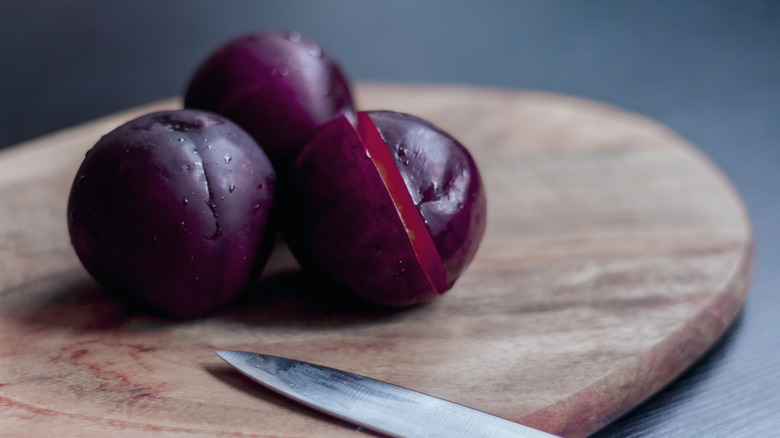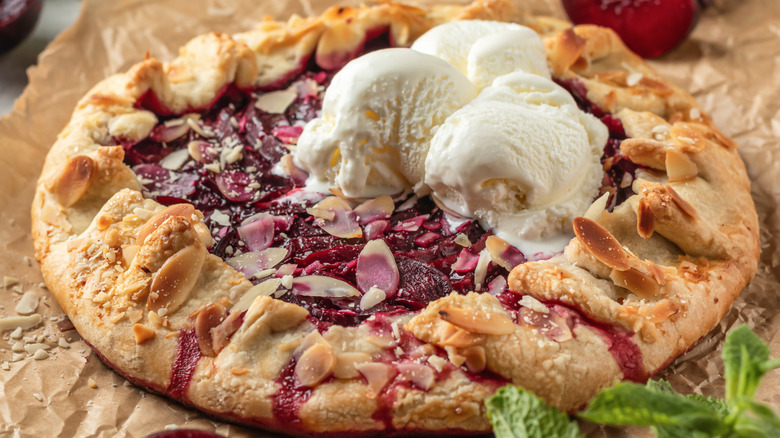The Trick To Freezing Plums For A Winter Treat
Some fruit, such as oranges, pineapples, and strawberries, can be found in the supermarket throughout the year. Other fruit, however, reminds us that even in this era of agricultural advancement, growing seasons are still a thing. With plums, you have to carpe diem — or rather, "carpe fructus" — and get them while they're available. One way to make the most of stone fruit season would be to produce pots and pots of jam with your surplus plums, but that pretty much locks you into a single application. Unless you eat PB&Js every day, keep your options open while preserving those plums through the winter. Trung Vu, who teaches pastry and baking at New York City's Institute of Culinary Education, suggests you freeze them.
The best fresh plums make the best frozen ones, so choose wisely while you're in the store. As Vu told The Takeout, "When sourcing fresh plums to freeze, look for ripe plums that yield to slight pressure. Once frozen, they will not continue to ripen, so to maximize flavor and sweetness, you want to ensure they are at their peak before freezing."
How to prep plums for freezing
Before freezing your plums, rinse them under cold water and allow them to dry thoroughly. You may then chop or slice them, although this isn't necessary if you plan to freeze them whole. Trung Vu cautions, "If freezing whole, you'll need to remove the pits after cooking them, so this may not be the best option if you intend to use the frozen plums for smoothies or a pie." Cut plums, however, do require a few extra steps, since you'll first need to flash-freeze them. This involves laying the slices or chunks on a tray (making sure they're not touching) and freezing them until they're solid before then transferring them to a zip-top bag or airtight storage container. As Vu explained, "This way, the pieces won't freeze together in one giant mass, and you'll be able to use them gradually."
If you prefer to cook plums without the skins, you can also remove the skin before freezing. The best way to do so is by blanching. According to Vu, this is done by cutting a small "X" in the bottom of each plum, then submerging the fruit in boiling water for 30 to 45 seconds to loosen the skin. The plums should then be dropped into ice water for at least a minute to prevent them from continuing to cook in any residual heat. Once the plums have been drained and dried, Vu said, "You can easily peel the skin off."
What to do with frozen plums
Frozen plums, like any frozen produce, will undergo a change in texture. As Trung Vu observed, "Once defrosted, the fruit will have broken down slightly and its juices will begin to leech out, so [it] won't have the crisp texture of a fresh plum for eating out of hand." They can, however, be used for just about any other application. Vu suggested making jam or blending the plums into smoothies, adding that they're great for baking.
Might we suggest using frozen plums to make the simple French dessert known as clafoutis? (Swap in plums for the blueberries in our recipe.) They can also be used in a galette, which is basically a panless pie. Since the fruit used in both desserts is typically cooked, the softer texture of frozen plums won't matter at all. Even our fancy plum trifle dessert recipe, which calls for raw plums, macerates them in sugar. As this has a softening effect, thawed plums will work here, as well.
You have plenty of time to figure out what to do with your frozen plums since, as the USDA assures us, frozen food can last indefinitely. Vu, however, opined that they're best used within six months, noting, "They can still be safe to eat after that period; however, the flavor and texture will degrade the longer they are kept."


